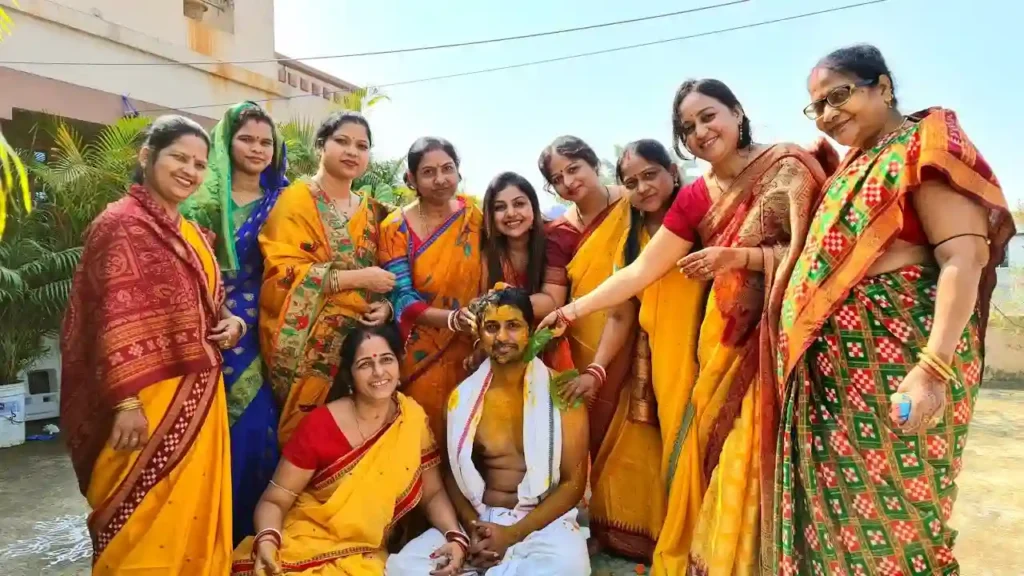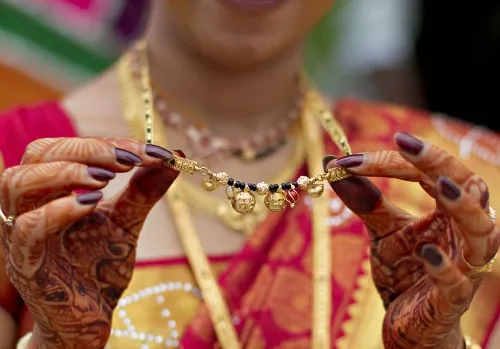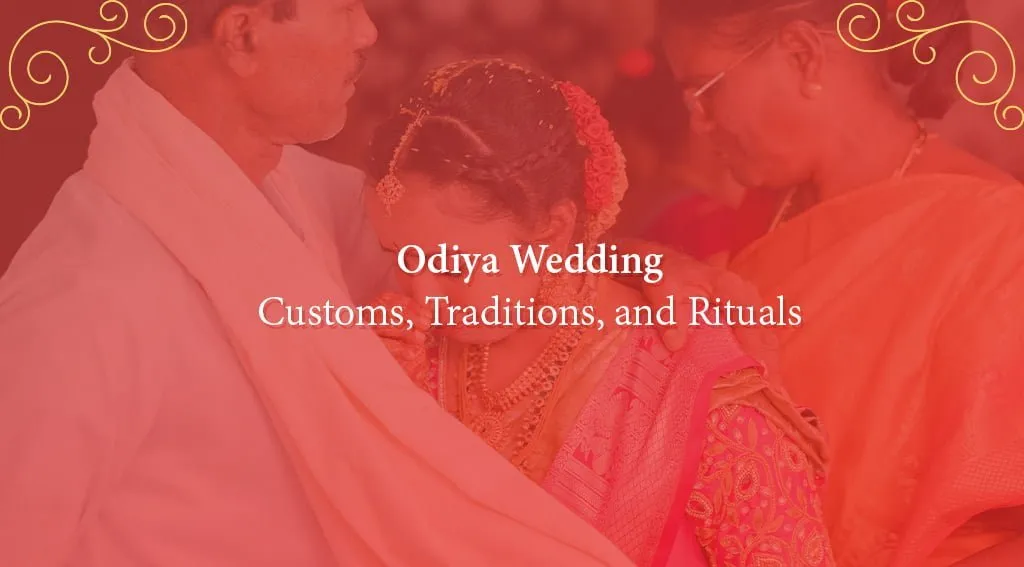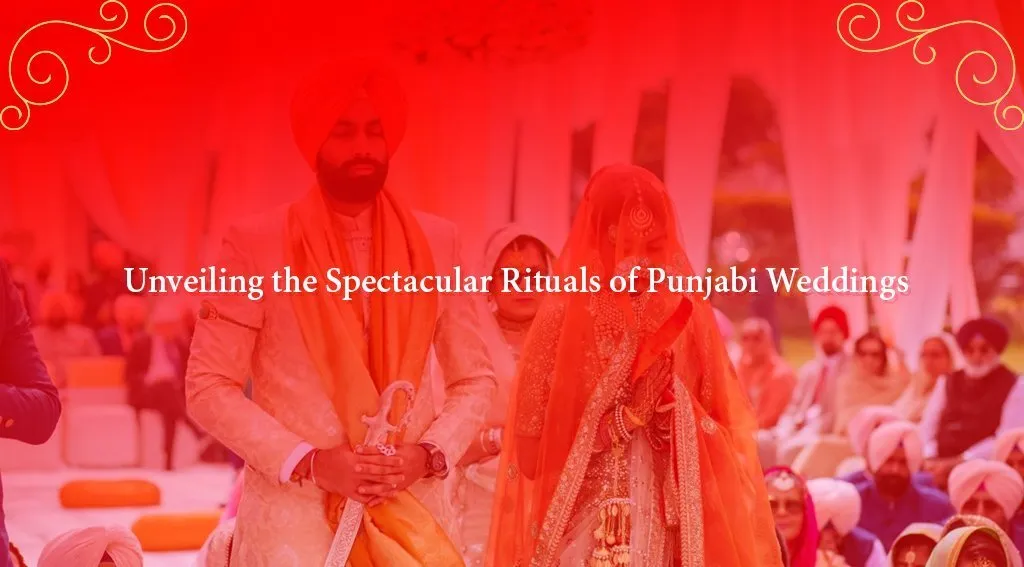Odiya weddings are full of vibrant colours, rich cultural traditions, and unique customs. The wedding ceremonies are celebrated with great enthusiasm and are a perfect blend of rituals and fun-filled festivities. The Odiya wedding customs and traditions are a reflection of the state’s rich heritage and cultural diversity.

In this article, we will take a closer look at the various customs, traditions, and rituals that make an Odiya wedding a unique and special celebration.
Odiya Pre-Wedding
Sagai – The Engagement Ceremony

The engagement ceremony, known as Sagai in Odisha, marks the beginning of the wedding festivities. It is an auspicious event where the families of the bride and groom exchange formal acceptance of the alliance. During Sagai, the groom’s family presents gifts to the bride’s family as a symbol of their acceptance.
Mangala Snaan: Purification of the Couple
The journey of an Odia marriage begins with the auspicious ritual of Mangala Snaan. It involves the ceremonial bath taken by the bride and groom on the morning of their wedding day. This ritual signifies the purification of the couple-to-be, both physically and spiritually, before they embark on their lifelong journey of love and togetherness.
Haldi Ceremony – Turmeric Paste

The Haldi ceremony is a pre-wedding ritual celebrated with much enthusiasm in Odiya weddings. It involves the application of turmeric paste on the bride and groom’s body. Family members and friends actively participate in this ceremony, applying turmeric paste on the bride and groom to bless them with good luck and happiness.
Mehendi Ceremony – The Art of Henna
The Mehendi ceremony holds a special place in Odiya weddings. It is a ritual where intricate henna designs are applied to the bride’s hands and feet. The bride, with her female relatives and friends, sits patiently as the skilled Mehendi artist weaves beautiful patterns on her skin.
Odiya Wedding Rituals and Customs
Barajatri – The Groom’s Arrival

Barajatri is a significant pre-wedding ritual where the groom, accompanied by his family and friends, arrives at the wedding venue in a grand procession. The groom is welcomed with much fanfare and traditional music. The bride’s family, dressed in traditional attire, receives the groom and his entourage with open arms.
Jaimala: Exchanging Garlands of Love
Jaimala is a delightful moment in an Odia wedding where the bride and groom exchange garlands of flowers. It is a symbolic gesture of acceptance and mutual respect. The exchange of garlands represents the bride and groom’s willingness to accept each other as life partners.
Hasta Melap

Hasta Melap is the joining of hands of the bride and groom. In this ritual, the groom’s right hand is placed on top of the bride’s right hand, showing their union. It represents their commitment to support each other throughout their married life.
Kanyadaan – Giving Away the Bride
Kanyadaan is a significant ritual in Odiya weddings where the bride’s father gives away his daughter to the groom. The father of the bride washes the groom’s feet and offers his daughter’s hand in marriage. This act symbolizes the father’s acceptance of the groom as his son-in-law and his trust in him to take care of his daughter.
Mangalsutra Ceremony

The Mangalsutra ceremony is when the groom ties a sacred thread, known as the Mangalsutra, around the bride’s neck. The Mangalsutra is a symbol of the bride’s married status and is believed to protect her from evil spirits. This ritual signifies the groom’s commitment to protect and support his wife throughout their married life.
Sindoor Daan – Applying the Vermilion
Sindoor Daan is a cherished ritual in Odiya weddings where the groom applies sindoor (vermilion) on the bride’s hair parting. The sindoor is a symbol of a married woman and signifies her commitment and love for her husband. The bride, after receiving the sindoor, becomes a suhagan, a married woman.
Saptapadi – The Seven Sacred Steps
Saptapadi is a pivotal ritual that takes place during the wedding. It involves the couple taking seven vows as they walk around the sacred fire. With each step, they make promises to support, love, and cherish each other throughout their married life. These vows form the foundation of their marital bond.
Odiya Post-Wedding Rituals and Customs
Kaudi Khela

During the ceremonies, the pair is seated and asked to play games to relax. They have fun with kaudi, which are little, white, and sparkly shells. The groom will try to pry them open while holding them in his tightened palm. The identical thing happens with the bride catching the shells in her hands and the husband attempting to collect them.
Juta Chhupai: Fun-filled Hide and Seek
Juta Chhupai is a playful tradition where the groom’s shoes are hidden by the bride’s sisters and female relatives. The groom has to find his shoes while the bride’s side negotiates for a gift or a sum of money in return. This light-hearted ritual adds an element of fun and signifies a friendly bond.
Griha Pravesh – Welcoming the Bride

Griha Pravesh is a warm and welcoming ritual where the bride enters her new home for the first time as a married woman. Mother-in-law performs a traditional aarti and applies a tilak on her forehead. The bride then enters the house, stepping on a plate filled with rice. It ensures prosperity and abundance in her new life.
Bou Bhat – The First Meal
Bou Bhat is an essential ritual where the bride, for the first time, cooks and serves a meal for her husband and in-laws. It symbolizes her acceptance into her new family and showcases her cooking skills. The bride takes great pride in preparing a delicious feast and receives blessings from her husband and in-laws for a happy married life.
Conclusion
In a Nutshell, an Odiya wedding is a celebration of customs, traditions, and rituals that have been passed down through generations. The ‘Baraat’ ceremony, ‘Kanyadaan’ ritual, and ‘Mangalsutra’ ceremony are just a few examples of the traditions that make an Odiya wedding unique and special.
This can be a challenging task, but with the right planning and resources, it can be a truly unforgettable experience. One such resource is Matrimilan, the best matrimonial website for Oriya Weddings. With its extensive database of profiles and personalized matchmaking services, Matrimilan can help you find the perfect match for your Odiya wedding.
FAQs
What is the significance of the ‘Mangalsutra’ ceremony in an Odiya wedding?
The ‘Mangalsutra’ ceremony is a significant ritual in an Odiya wedding. It is the tying of the sacred thread around the bride’s neck by the groom. The ‘Mangalsutra’ signifies the bond of love and commitment between the bride and groom. It is a symbol of the groom’s acceptance of the bride as his wife.
What are some of the traditional customs followed during the ‘Kanyadaan’ ritual?
‘Kanyadaan’ is a significant ritual in an Odiya wedding. It is the giving away of the bride by her father to the groom.
What is the significance of the ‘Baraat’ ceremony in an Odiya wedding?
The ‘Baraat’ ceremony is a significant ritual in an Odiya wedding. It is the groom’s wedding procession, where he arrives at the wedding venue on a decorated horse or car. The groom’s family and friends accompany him.





